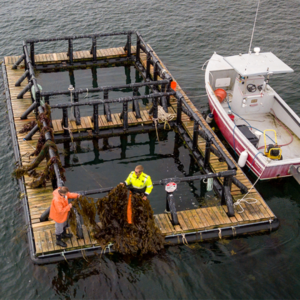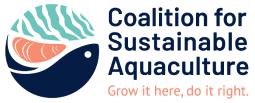What does sustainable aquaculture look like? Ideally, it would nourish people, support livelihoods, and produce something farmers and chefs alike can be proud of. It would do this without harming the environment—maybe it would even help the environment. On top of that, it wouldn’t harm or out compete wild-caught fisheries. Can you picture it?
This might sound like sustainable seafood fantasy, but researchers at the University of New Hampshire (UNH) have teamed up with Sea Grant, commercial fishermen, and local chefs to make it a reality.

AquaFort, their moored floating farm off the coast of New Castle, NH, grows steelhead trout alongside blue mussels and sugar kelp in an integrated system. The mussels and kelp thrive on the nitrogen waste from the trout, filtering the water to make a healthier environment for the quick-growing fish. Commercial fishermen have partnered with the project to help harvest and sell the fish, and eventually all three species could be sold to local restaurants and breweries.
While AquaFort is a pilot-scale research project, it provides an admirable model of sustainable aquaculture done in partnership with fishermen and coastal communities. We talked to Dr. Mike Coogan, UNH aquaculture scientist, Ward Byrne, a lobsterman and commercial fisherman partner of the project, and Jeremy Sewall, head chef at AquaFort restaurant partner Row 34 and member of the Coalition for Sustainable Aquaculture, to learn more.
Q: What is “integrated multi-trophic aquaculture,” and what makes it special?
Mike Coogan: Integrated multi-trophic aquaculture, or IMTA, involves farming species from different levels of the food chain. The standard approach, focusing on a single high-value species, can lead to environmental, animal welfare, and economic issues. Growing lower trophic species like mussels and kelp improves water quality when these species uptake nutrients that can cause algal blooms, fish die offs and upset ecosystem function. And, they can be a high-value product themselves, offering additional income and financial stability through diversification.
Jeremy Sewall: IMTA is a self-contained ecosystem, where all the harvested species benefit from each other in some way. For the farmer, having multiple species or products to sell makes it a unique way to farm the ocean. Also, the ability to grow multiple species from year to year seems more adaptable to different growing environments.
Q: Why was it important to you to work with local fishermen?
Coogan: No one knows the waters as well as fishermen—they provide us with a wealth of knowledge on local conditions and the markets to sell our product. Fishermen have been a pillar of New England for centuries, and working with them not only supports the work they do, but it helps us maintain a culture in the region.
Q: Partners: What drew you to work with AquaFort?
Ward Byrne: They were looking for somebody to help them out, and my name got thrown in the ring. It’s a cool gig, for sure. You put an 8-inch trout in a pen in October and then in May you pull it out and it’s 6 pounds—it’s unbelievable! And I’m providing food to people, which to me is the ultimate goal.
Sewall: The first thing for me was that it’s a locally raised product. The AquaFort IMTA method felt like a responsible way to approach farming the ocean. It has been a great experience.
Q: How do you see operations like Aquafort supporting fishing communities and local food systems to adapt to climate change?
Coogan: The AquaFort was built with the community in mind. It is small-scale and reasonably affordable, but produces a surprising amount of seafood for nearby markets. By producing locally we can ensure seafood quality, create jobs, and reduce our environmental footprint. Fishermen can run their own AquaFort to make additional income and reduce some of the uncertainty that comes with capture fisheries.
Byrne: It’s crazy times, you just never know. Definitely, if I had to, I know for certain that I can go farm trout. If lobster fishing ever crashes, I have something I can fall back on.
Sewall: Fishermen are going to need to diversify in some way as the oceans change. Having the ability to catch wild seafood commercially and grow seafood through responsible aquaculture is going to be important for fishing communities all over the country. A balance of farmed and wild harvested seafood is going to be important for the long-term health of food systems and the ocean.
Q: What would need to happen to make this a viable business model for farmers and fishermen across the Northeast?
Sewall: Larger pens to be able to harvest more fish, buy in from local fisherman, government assistance to start the farms, a diversity of harvestable shellfish to grow alongside the fish are just a few things that need to happen. It is a major challenge to get sites permitted. We also need to continue to educate the public on responsible farmed seafood.
Byrne: The biggest problem in our area is leases. Permitting is really difficult. Bigger pens mean you can grow more fish, but the leases are restricted because fish pens produce nitrates. Because UNH also grows sugar kelp, which neutralizes the nitrates, bigger pens might be possible.
Coogan: This is a major effort of ours. Now that we’ve proven that this works conceptually, we’re analyzing the economics. Our small-scale IMTA model can be profitable, especially with more creative markets, like smoked or other value-added products that are all the rage now. To make this viable at a larger scale, though, we need a more streamlined regulatory process. If we can move further offshore to deeper water, we could increase our production exponentially.
Another huge part of our work is engaging with the community. Aquaculture often gets a bad rap, and farmers rarely get to tell our story. When we take people out to see firsthand how our fish, mussels, and kelp are grown, they leave as fans of what we do. And if they get to try our seafood, it’s game over.
Q: What’s next for the UNH Aquafort research?
Coogan: We are working with partners around the world to set up Aquaforts in different environments, and with completely different species. We are also reengineering our farm design to make it more affordable, durable, and productive. Outside of the Aquafort, we are starting a scallop aquaculture project, working with a bunch of fishermen. We modeled our growout technique based on lobster fishing methods so that fishermen can have an alternative income source. We also have a restoration component to ensure we are supporting wild fisheries, and are doing tons of work with whale-safe fishing and aquaculture gear.
Q: What’s your vision for sustainable U.S. aquaculture in the future?
Byrne: Let the fishermen collect the data. Nobody knows the ocean better than fishermen.
Coogan: Small-scale, community and ecosystem-based aquaculture will play a major role in feeding the world. In the U.S., we need to stop importing seafood from around the world and produce food right here. We’ve got the largest Exclusive Economic Zone in the world and should be utilizing it.
Sewall: We need to support responsibly raised seafood and eat a variety of different farmed and wild fish. One of my dreams is to see farmed fish introduced into local schools as part of the lunch program. Introducing a younger generation to seafood is one way to help the next generation eat differently.
